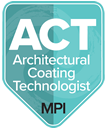MPI's Essentials of Paint and Painting Technology eCourse remains the industry’s foundational standard for professionals working with coatings, and now fully modernized and optimized for today’s learners.
This course teaches the essential principles and practices of commercial/architectural paints and coatings with a focus on professionals that are directly involved in any aspect of commercial/architectural painting projects.
The new Essentials of Paint and Painting Technology eCourse launched in June 2025.
Updates include:

Topics Covered:
Prerequisites:
Course Information





 Students who successfully complete this course will become MPI “Architectural Coating Technologists” (ACT) and will receive the following award and badge.
Students who successfully complete this course will become MPI “Architectural Coating Technologists” (ACT) and will receive the following award and badge.
Architects, Specifiers, Interior Designers & Inspectors
Facility Owners/Managers & Property Managers
General Contractors, Painting Contractors and Builders
Sales Representatives & Retail Store Staff
Paint Coating Technology
Paint Standards
Paint Specification
Paint Application
Paint Safety
Paint Color
Paint Types & Manufacture
Paint and the Environment

This course would be very useful in helping to improve anyone’s coatings education.
I’ve been in the coatings industry for 22 years, with the last 10 years on the commercial / architectural segment of the business. The MPI Level 1 course was very informative and a very good refresher to help bring back some of the basics that I learned early in my paint career. The online learning was informative, easy to follow and allowed me to work at my own pace. This course would be very useful in helping to improve anyone’s coatings education, while challenging them to learn material they aren’t regularly trained in.
Product Training Manager, PPG Architectural Coatings

It is great learning tool for either a commercial paint sales person or contractors/estimators working in the field"
I’ve been in the paint industry for 26 years. I thought the course covered a wide range of material and I believe it is great learning tool for either a commercial paint sales person or contractors/estimators working in the field.
Territory Manager Dealer-Hardware Group, Pratt & Lambert

It was definitely beneficial"
It was a real good refresher. I’ve been at this for 34 years and it brought back a lot of things I’d forgotten. It was definitely beneficial. MPI is very prevalent in our marketplace and the name is well recognized so it will be helpful for me to tell my customers I’m now an MPI Certified Architectural Coating Technologist and I look forward to getting my MPI Coating Specialist certification as well.
CSI, CDT, LEED AP, Dunn-Edwards

This training has added to my arsenal of resources needed to succeed at my job
I’m the Store Manager for the Mequon Branch and I call on all types of customers. I’ve been in the paint industry for 6 years and had no prior paint knowledge. I thought the course was very useful and have already gone back to it a couple times as a resource. This training has added to my arsenal of resources needed to succeed at my job. I will continue to go back to my notes for assistance.
Store Manager, Hallman Lindsay Paints